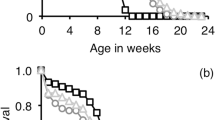Summary
Insect size tactics or developmental strategies are discussed in relation to decisions individuals make about when to mature. Such decisions carry with them costs and benefits in terms of that individual's reproductive success. Whenever size affects fitness, selection should act such that individuals evaluate the costs and benefits due to changes in size and should mature when the ratio of benefit to cost is maximized.
Predictions about seasonal changes in adult sizes within a population are tested on two species of mole cricket, Scapteriscus acletus and vicinus. Specifically, individuals maturing in the fall should be larger than average because there is no cost associated with delayed reproduction since reproduction occurs only during spring months. Smaller than average individuals should remain in juvenile stages and get larger before reproducing. Also it is predicted that as the spring reproductive season progresses a greater proportion of smaller individuals should mature because the costs due to delaying reproduction increase. The changes in seasonal distribution of adult sizes of mole crickets support the predictions and suggest that individuals make decisions about when to mature based on costs and benefits associated with changes in size.
Similar content being viewed by others
References
Alcock J (1979) The evolution of intraspecific diversity in male reproductive strategies in some bees and wasps. In: Blum MS, Blum NA (eds) Sexual selection and reproductive competition in insects. Academic Press, New York, pp 381–402
Andersen J, Nilssen AC (1983) Intrapopulation size variation of free-living and tree-boring Coleoptera. Can Entomol 115:1453–1464
Blakley N (1981) Life history significance of size-triggered metamorphosis in milkweed bugs (Oncopeltus). Ecology 62:57–64
Blakley N, Goodner SR (1978) Size-dependent timing of metamorphosis in milkweed bugs (Oncopeltus) and its life history implications. Biol Bull 155:499–510
Borgia G (1979) Sexual selection and the evolution of mating systems. In: Blum MS, Blum NA (eds) Sexual selection and reproductive competition in insects. Academic Press, New York, pp 19–80
Charnov EL (1979) Natural selection and sex change in pandalid shrimp: test of a life-history theory. Amer Nat 113:715–734
Dawkins R (1980) Good strategy or evolutionary stable strategy? In: Barlow GW, Silverberg J (eds) Sociobiology: beyond nature/nurture? Westview Press, Boulder, Colo. pp 331–367
Dearn JM (1977) Variable life history characteristics along an altitudinal gradient in three species of Australian grasshopper. Oecologia (Berlin) 28:67–85
Denno RF, Dingle H (eds) (1981) Insect life history patterns: habitat and geographical variation. Springer, Berlin Heidelberg New York
Forrest TG (1980) Phonotaxis in mole crickets: its reproductive significance. Fla Entomol 63:45–53
Forrest TG (1983) Calling songs and mate choice in mole crickets. In: Gwynne DT, Morris GK (eds) Orthopteran mating systems: reproductive competition in a diverse group of insects. Westview Press, Boulder, Colo. pp 185–204
Forrest TG (1986) Oviposition and maternal investment in mole crickets (Orthoptera: Gryllotalpidae): effects of season, size, and senescence. Ann Entomol Soc Amer 79:918–924
Hayslip NC (1943) Notes on biological studies of mole crickets at Plant City, Florida. Fla Entomol 26:33–46
Hinton HE (1981) Biology of insect eggs. Pergamon Press, Oxford
Hudson WG (1987) Variability in development of Scapteriscus acletus (Orthoptera: Gryllotalpidae). Fla Entomol (in press)
Masaki S (1967) Geographical variation and climatic adaptation in a field cricket (Orthoptera: Gryllidae). Evolution 21:725–741
Masaki S (1978) Climatic adaptation and species status in the lawn ground cricket. II body size. Oecologia (Berlin) 35:343–356
Masaki S, Walker TJ (1987) Cricket life cycles. Evol Biol 21:349–423
Matheny EL (1981) Contrasting feeding habits of pest mole cricket species. J Econ Entomol 74:444–445
Palmer JO (1984) Environmental determinants of seasonal body size variation in the milkweed leaf beetle, Labidomera clivicollis (Kirby) (Coleoptera: Chrysomelidae). Ann Entomol Soc Amer 77:188–192
Peters RH (1983) Ecological implications of body size. Cambridge University Press, Cambridge
Peters TM, Barbosa P (1977) Influence of population density on size, fecundity, and development rate of insects in culture. Ann Rev Entomol 22:431–450
Remmert H (1981) Body size of terrestrial arthropods and biomass of their populations in relation to the abiotic parameters of their milieu. Oecologia (Berlin) 50:12–13
Roff D (1980) Optimizing development time in a seasonal environment: the ‘ups and downs’ of clinal variation. Oecologia (Berlin) 45:202–208
Roff D (1981) On being the right size. Amer Nat 118:405–422
Roff D (1983) Phenological adaptation in a seasonal environment: a theoretical perspective. In: Brown VK, Hodek I (eds) Diapause and life cycle strategies in insects. Dr. W. Junk Publishers, Boston, pp 253–270
Rogers JS (1942) The crane flies (Tipulidae) of the George Preserve, Michigan. Misc Publ Mus Zool Univ Mich #53
Schoener TW, Janzen DH (1968) Notes on the environmental determinants of tropical versus temperate insect size patterns. Amer Nat 102:207–224
Slansky F (1982) Insect nutrition: an adaptationist's perspective. Fla Entomol 65:45–71
Smith-Gill SJ, Berven KA (1979) Predicting amphibian metamorphosis. Amer Nat 113:563–585
Sweeney BW, Vannote RL (1978) Size variation and the distribution of hemimetabolous aquatic insects: two thermal equilibrium hypotheses. Science 200:444–446
Tanaka A (1981) Regulation of body size during larval development in the German cockroach, Blatella germanica. J Insect Physiol 27:587–592
Thornhill R, Alcock J (1983) The evolution of insect mating systems. Harvard University Press, Cambridge
Ulagaraj SM (1975) Mole crickets: ecology, behavior, and dispersal flight (Orthoptera: Gryllotalpidae: Scapteriscus). Env Entomol 4:265–273
Walker TJ (1982) Sound traps for sampling mole cricket flights (Orthoptera: Gryllotalpidae: Scapteriscus). Fla Entomol 65:105–110
Walker TJ, Nation JL (1982) Sperm storage in mole crickets: fall matings fertilize spring eggs in Scapteriscus acletus. Fla Entomol 65:283–285
Walker TJ, Nickle DA (1981) Introduction and spread of pest mole crickets: Scapteriscus vicinus and S. acletus reexamined. Ann Entomol Soc Amer 74:158–163
Walker TJ, Reinert JA, Schuster DJ (1983) Geographical variation in flights of the mole cricket, Scapteriscus spp. (Orthoptera: Gryllotalpidae). Ann Entomol Soc Amer 76:507–517
Werner EE (1986) Amphibian metamorphosis: growth rate, predation risk, and the optimal size at transformation. Amer Nat 128:319–341
Wilbur HM, Collins JP (1973) Ecological aspects of amphibian metamorphosis. Science 182:1305–1314
Author information
Authors and Affiliations
Rights and permissions
About this article
Cite this article
Forrest, T.G. Insect size tactics and developmental strategies. Oecologia 73, 178–184 (1987). https://doi.org/10.1007/BF00377505
Received:
Issue Date:
DOI: https://doi.org/10.1007/BF00377505




